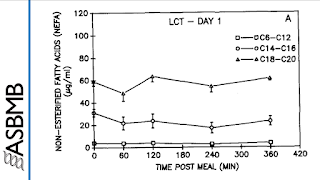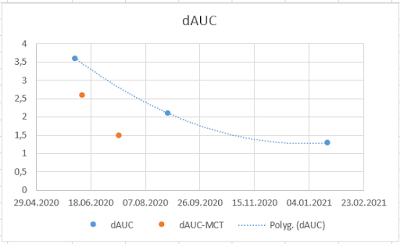Metabolic syndrome - causes and solutions
If you ask doctors what causes metabolic syndrome, they will probably tell you that it is complicated, many factors such as insulin resistance, stress, sweet drinks, etc. When you ask what causes insulin resistance, you will probably learn that there are a number of risk factors, it may lead to genetics, it's a common excuse when they don't know the cause.
This is a desperate situation, especially when you consider that the metabolic syndrome is, according to recent research, at the beginning of all the so-called diseases of civilization - type 2 diabetes, obesity, high blood pressure but also cardiovascular diseases, Alzheimer's disease, etc.
At the same time, it is known how to produce insulin resistance and hyperinsulinemia within 48 hours, according to a study from 1995, for example, an infusion of intravenous nutrition containing vegetable oils is enough. Don't you believe? Producers of intravenous nutrition have to know this for decades, they are obviously trying to solve it somehow, and so far they have not been able to solve it completely. This is evidenced by various studies that are looking for a better composition but still have some problems. While the glucose infusion does not cause any problems, or only a small increase in insulin, when you add a fat emulsion to the infusion, you produce insulin resistance within a few hours. But hold on, it will cause liver damage over time, especially in children, and it will also damage your white blood cells and therefore your immune system. If it also causes metabolic syndrome is a matter of time, but patients cannot be on this diet for long.
What emulsion they add? Hold on, it's a mixture of canola oil and safflower oil, 66 % of polyunsaturated linoleic acid. If you visit the Tucker Goodrich website, you will find all the information on how it works and in which toxic products linoleic acid C18:2n-6 is transformed.
One of the main problems caused by linoleic acid is the ability to be easily peroxidized by glucose or even easier by fructose or be directly converted to other poisons. It causes degradation of cardiolipins in the inner membrane of mitochondria, which disrupts fat burning. This increases the level of free fatty acids in the blood, mitochondria is signaling that fats are burned, but this burning is limited due to omega-6. Nevertheless, the entry of glucose into the cells is reduced as in the actual burning of fats, so that insulin resistance is induced. If increased insulin is added to this condition, triglycerides are formed inside the cells. These, unlike free fatty acids, do not pass through the cell wall and then permanently affect cell function.
So does the same situation sometimes occur in the human body even without infusion nutrition? Of course. If you eat those beautiful yellow vegetable oils full of linoleic omega-6 acid, then they will be transported from the digestive tract by means of such little trucks called chylomicrons to adipose tissue. There they wait for a time when you will not eat for a while and they will be released for burning, preferably omega-6 will be released, because they are the most vulnerable and not suitable for long-term storage. So there is an infusion-like situation between meals, we produce insulin resistance. There is still a lack of increased insulin, which helps to form triglycerides inside the cells. We will deliver it with a carbohydrate breakfast.
So once again, we induce insulin resistance by having to meet elevated levels of free omega-6 linoleic acid in the blood with elevated levels of insulin, which is a typical situation after a meal with any amount of carbohydrates or proteins. Linoleic acid is supplied by our adipose tissue if we have ever eaten it before. This is followed by a forced reduction in fat burning which raises the level of free fatty acids and stimulates the production of triglycerides inside the cells.
So we already know why it is necessary to increase insulin levels. But how does this increased secretion occur? What affects the sensitivity of insulin secretion? Well, this is effect of elevated free fatty acids in the blood and probably triglycerides formed in the beta cells of the pancreas. These first increase insulin secretion at the same glucose level, creating hyperinsulinemia. Later, sensitivity begins to decline, insulin secretion is insufficient and needs to be compensated by higher glucose levels after a carbohydrate meal, metabolic syndrome (carbohydrate intolerance, higher dAUC in OGTT) develops, and after a long time so many triglycerides accumulate in beta cells that beta cells stop working. And we have type two diabetes.
So what needs to be done to avoid the conditions in which the metabolic syndrome arises?
- Reduce the level of free long fatty acids in the blood, espetially polyunsaturated linoleic acid omega-6.
- Avoid excessive insulin levels in the blood after a meal.
Just solve at least one point and it should work. So we can solve point 2 with a low-carbohydrate diet, which reduces insulin levels, increases fat burning and, over time, reduces free fatty acids in the blood. But it will take a while, because if you have consumed omega-6 oils in the past, they will be released and make damage for days, weeks, maybe years. So even if you immediately limit them to absolute zero, it won't be easy. And to limit to zero the intake of omega-6 fats is practically impossible, they are in everything. In pork and chicken, in lard, in various sauces, the least is in butter, beef and coconut oil.
There is another simpler solution that solves the first point. It is called MCT oil containing saturated medium length fats C8:0 and C10:0. It allows you to stimulate fat burning so much that the blood is cleared of free fatty acids within one hour. Yes, you read that right, it improves insulin resistance and hyperinsulinemia almost immediately, and with prolonged use you have a chance to get rid of the metabolic syndrome completely.
The picture shows the situation after a meal without MCT. Note the C18-C20 levels of about 60 ug/ml.
This is caused by one meal of 1000 kcal with 40% MCT fat, or about 40 g of MCT. Why doesn't anyone know about it? I won't tell you. All I know is that it works. In terms of quantity, I would start with 10 g of MCT oil 1:1 with butter in morning coffee or tea or whatever you can think of (e.g. soup). It is important that the main ingredients are C8:0 and C10:0 oils, not C12:0 (this could increase fat storage in the liver, you certainly do not want this, be careful with coconut oil). You don't have to believe me, but you can try it for yourself using the OGTT test described in the previous post. It is thus possible to reduce the dAUC by up to 1 mmol.hr/L almost immediately. For maximum results, it is advisable to limit the amount of carbohydrates in the diet, but if you add MCT oil, you do not have to be so strict. So good luck.
https://en.wikipedia.org/wiki/Metabolic_syndrome
Effects of a 48-h Fat Infusion on Insulin Secretion and Glucose Utilization
Effect of olive oil-based emulsion on human lymphocyte and neutrophil death
https://www.rxlist.com/liposyn-drug.htm
http://yelling-stop.blogspot.com/
Dysregulation of Fatty Acid Metabolism in the Etiology of Type 2 Diabetes
Changes in blood lipids during six days of overfeeding with medium or long chain triglycerides








Does 10g of MCT along with a big big meal make any difference?
ReplyDeleteI think it can work as prevention, protection against overexpression of SCD1 and conversion of all fats to unsaturated, except of the MCT fraction. MCT's maintain mitochondrial fat metabolism of long chain saturated fats. Without MCT fraction, overactivated peroxisomes will block long chain FA to enter mitochondria by elevating malonyl-CoA, this would activate SCD1 and start storing fats and later metabolic syndrom.
Deletehttps://pubmed.ncbi.nlm.nih.gov/33122393/